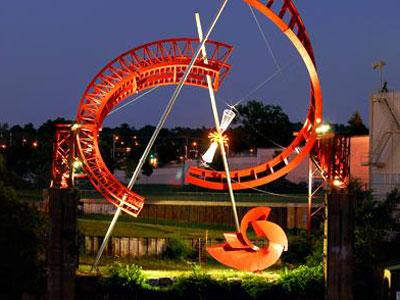Alice Aycock's Sense of Vortex at Parrish

A casual viewer might not immediately grasp that the sometimes cold, severe, complex, and confounding structures of Alice Aycock are rich in history and narrative. Yet her evocative forms and accompanying text allow for a satisfying and engrossing journey through her meticulously created mythical structures and geographies.
While much of her work deals with mass and colossal size, it is in the more intimate world of her drawings where most of her meaning is made manifest. It is difficult to imagine that no one thought of such a show prior to this.
Terrie Sultan, the director of the Parrish Art Museum, recalled recently that it was at a dinner for the Salomon Contemporary installation of “Sand/Fans” during the Parrish’s “Sand: Memory, Meaning, and Metaphor” show in 2008 that the subject came up. “I was speaking to Jonathan Fineberg, an Aycock scholar, and he mentioned that no one had done a show of her drawings. Immediately, I said we will do that show. It was that easy.”
Perhaps it was easy to decide to do, but the resulting exhibition is a major undertaking. Functioning as a retrospective in paper and maquettes, it spans the years 1971 to the present and several Parrish galleries, as well as the Grey Art Gallery at New York University. The show, which is up through July 13, is divided chronologically with the early work installed not far from where some of it might have been seen originally at the Greene Street Gallery. The Parrish picks up at the year 1984.
It is a perfect visual dividing line. Aycock was never a Minimalist in the traditional sense, even though she studied with Tony Smith at Hunter College. Instead, as noted in Mr. Fineberg’s essay, she followed more closely the path of Robert Morris, another Minimalist artist and Hunter professor, who began to break free from the strictures of that movement in 1968 to focus more on process and away from form. When Aycock embraces form it is for a disjunctive purpose. The structures she envisions and often realizes are taken away from their traditional meanings and purposes to serve only her imagined reason for their existence.
Yet the early work does have a minimal feeling to it, even when it too moves away from form. Keeping the black-and-white documents of her early buildings together with her early maquettes demonstrates the range of what the artist accomplished in creating sculptures of essentially nonfunctioning buildings, rudimentary in nature but full of meaning, with a narrative often drawing on her grandmother’s tales, her childhood fears of getting lost and the dark, and, eventually, mysticism and mythologies from several cultures.
The Grey Art Gallery show leads off with “Sand/Fans,” originally mounted in 1971, and it too is a good choice. Ms. Aycock told me in 2008 how seminal a work it was for her. It was a time when artists were approaching projects from an interdisciplinary viewpoint and experience was as much a part of the artistic method as objects had been in the decades before. “We were attacking the validity of just an object that sits there and does not change,” she said.
Remounting the work brought back to her some of the earlier forms of inspiration. The fans themselves and their blades spinning have always had some presence in her work, but the drawings of the past few years have drawn repeatedly on that sense of a vortex, through spinning shapes and curves, which reflect the way the wind of the fans form perfectly proportioned curves in the sand.
It is obvious in the maquettes, both in New York City and in Water Mill, how these forms manifested themselves. In the late work there is an even more frenzied approach, highlighted, as most of the work at the Parrish, in bold color.
The separation into two venues is a positive aspect of the show. I liked having time to take each one in and digest it at some remove. The show is traveling to Santa Barbara, Calif., where it will be all in one place, and I think that would be a bit much. Although I’m not much of a strict chronologist, it was disorienting going into the Parrish show without having seen the earlier work first. Even though I was familiar with it, I think the later work is enriched by the experience of the earlier. Yet sometimes the New York installation felt a bit sterile, with all the rustic structures preserved in the gray tonality of the photographs.
The richly illustrated catalog and essay by the curator are a satisfying accompaniment to the show and capture the depth and breadth of the artist’s influences and sources of meaning. A videotaped interview with the artist, on view in the city, is also illuminating, as she explains several of her early works. It is a huge show and the fact that it deals only with drawings, reproductions, and models, and not her full-scale structures underlines how prolifically creative the artist has been over four decades.
"Ghost Ballet (2007)," a set of four drawings in ink on paper from 2008-2012 inpsired by the sculpture
installaiton in Nashville, Tenn. see above.
"Sand/Fans" from its original installation in 1971.
"Maze--Aerial View," from 1972, another early work by the artist, built on property she owned in Pennsylvania.
"The Miraculating Machine in the Garden," a maquette from 1980 in aluminum, steel, plastic, copper, electric bulbs, and rubber.
"The Silent Speakers: Every Day I'm Born, Every Night I Die (1984)" is an ink and watercolor drawing made from a 1984 project in 1990.
"From the Series Entitled: 'Sum Over Histories': Timescape #5 Over the Landscape of the Pacific Ocean" is one of the latest works in the show, completed in 2011.
